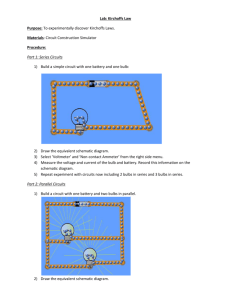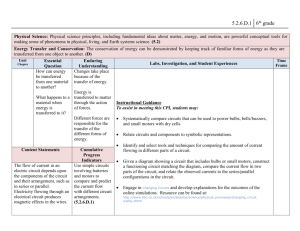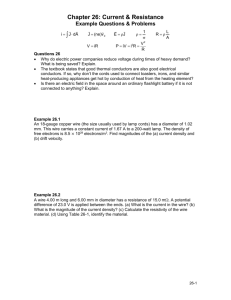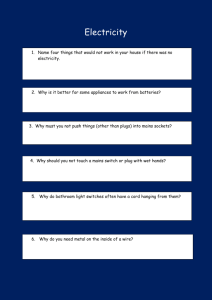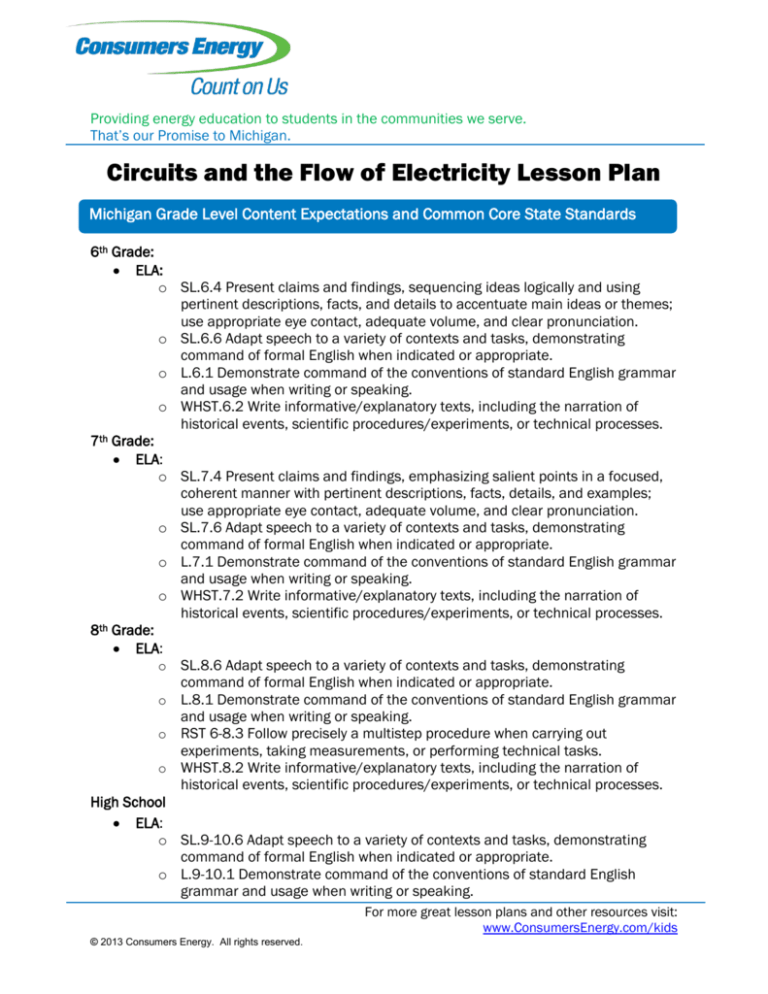
Providing energy education to students in the communities we serve.
That’s our Promise to Michigan.
Circuits and the Flow of Electricity Lesson Plan
Michigan Grade Level Content Expectations and Common Core State Standards
6th Grade:
ELA:
o SL.6.4 Present claims and findings, sequencing ideas logically and using
pertinent descriptions, facts, and details to accentuate main ideas or themes;
use appropriate eye contact, adequate volume, and clear pronunciation.
o SL.6.6 Adapt speech to a variety of contexts and tasks, demonstrating
command of formal English when indicated or appropriate.
o L.6.1 Demonstrate command of the conventions of standard English grammar
and usage when writing or speaking.
o WHST.6.2 Write informative/explanatory texts, including the narration of
historical events, scientific procedures/experiments, or technical processes.
7th Grade:
ELA:
o SL.7.4 Present claims and findings, emphasizing salient points in a focused,
coherent manner with pertinent descriptions, facts, details, and examples;
use appropriate eye contact, adequate volume, and clear pronunciation.
o SL.7.6 Adapt speech to a variety of contexts and tasks, demonstrating
command of formal English when indicated or appropriate.
o L.7.1 Demonstrate command of the conventions of standard English grammar
and usage when writing or speaking.
o WHST.7.2 Write informative/explanatory texts, including the narration of
historical events, scientific procedures/experiments, or technical processes.
8th Grade:
ELA:
o SL.8.6 Adapt speech to a variety of contexts and tasks, demonstrating
command of formal English when indicated or appropriate.
o L.8.1 Demonstrate command of the conventions of standard English grammar
and usage when writing or speaking.
o RST 6-8.3 Follow precisely a multistep procedure when carrying out
experiments, taking measurements, or performing technical tasks.
o WHST.8.2 Write informative/explanatory texts, including the narration of
historical events, scientific procedures/experiments, or technical processes.
High School
ELA:
o SL.9-10.6 Adapt speech to a variety of contexts and tasks, demonstrating
command of formal English when indicated or appropriate.
o L.9-10.1 Demonstrate command of the conventions of standard English
grammar and usage when writing or speaking.
For more great lesson plans and other resources visit:
www.ConsumersEnergy.com/kids
© 2013 Consumers Energy. All rights reserved.
Providing energy education to students in the communities we serve.
That’s our Promise to Michigan.
o RST 9-10.3 Follow precisely a complex multistep procedure when carrying out
experiments, taking measurements, or performing technical tasks, attending
to special cases or exceptions defined in the text.
o SL.11-12.6 Adapt speech to a variety of contexts and tasks, demonstrating
command of formal English when indicated or appropriate.
o RST 11-12.3 Follow precisely a complex multistep procedure when carrying
out experiments, taking measurements, or performing technical tasks;
analyze the specific results based on explanations in the text.
o L.11-12.1 Demonstrate command of the conventions of standard English
grammar and usage when writing or speaking.
o WHST.9-12.2 Write informative/explanatory texts, including the narration of
historical events, scientific procedures/experiments, or technical processes.
Science:
o P4.10C Given diagrams of many different possible connections of electric
circuit elements identify complete circuits, open circuits, and short circuits
and explain the reasons for the classification.
o P4.10D Discriminate between voltage, resistance, and current as they
apply to an electric circuit.
Lesson Outcome
The student will apply understanding of current electricity to design a circuit and describe its
workings.
Rationale / Purpose for Lesson
To understand current electricity, many vocabulary words must be introduced. The first part
of this lesson uses a hands-on, problem-solving activity that helps students define the
vocabulary terms and demonstrate the terms’ relationships. After gaining foundational
understanding, students create their own circuits.
Resources / Materials Required
12 small balls (such as tennis balls or other soft balls)
Copies of “Making Circuits” handout (below)
1 Circuit Kit for each group. Circuit Kits contain 1-D Cell battery, Battery holder, 2 - 1.5
volt bulbs, 2 sockets for the light bulbs (or E-10 light bulb bases), and 4 pieces of 6-inch
insulated solid strand copper wire (18–22 gauge), with one inch of insulation removed at
each end wire. Materials for Circuit Kits can be purchased at a local hardware store.
Paper to record observations
Pen or pencil to record observations
For more great lesson plans and other resources visit:
www.ConsumersEnergy.com/kids
© 2013 Consumers Energy. All rights reserved.
Providing energy education to students in the communities we serve.
That’s our Promise to Michigan.
Introduction
Ask two student volunteers to go to the front of the classroom. Assign one student the
role of “the battery” and the other student the role of “the light bulb.” It may be helpful
to have each student stand by the chalkboard with a picture of his or her role (the
battery or light bulb) nearby.
Ask the students, “How can the battery give energy to the light bulb in order to create
light?” Provide “the battery” with a basket of balls. Explain that the balls represent the
electrons of an atom. Draw a diagram of an atom and discuss the negative charge of
electrons. Explain that the electrons can carry energy and it is the flow of electrons that
can generate electricity.
Have “the battery” toss the balls to the light bulb. Now the light bulb has been supplied
energy to generate light.
Procedures
Once “the battery” has thrown all of the balls to “the light bulb” the supply of energy to
the light bulb is exhausted and no more light can be generated. Ask the students, “How
can the light bulb be lit for a longer period of time?” Possible answers:
o Have more balls
o Have the light bulb return the balls to the battery quickly
While the first answer would still work for only a limited time, the second answer
introduces the term circuit. A circuit is a complete path; in this case the path is
completed when the balls are returned to their starting point and can then be
given more energy and used again.
Ask the students, “How could the light bulb give off light that is brighter?” Possible
answers:
o Have each ball carry more energy by making the balls bigger. (In this case,
using basketballs for example.) However, in an atom, it is easier to move the
small, negatively charged electrons than the larger, positive charges.
o Throw the ball harder. This introduces the term voltage (V). Voltage is the
measure of pressure under which electricity flows; in this case it is the
measure of how much energy or force “the battery” is giving each ball. If the
same number of balls are thrown, but each ball is given more force or energy,
more power will be sent to the light bulb.
o Throw the balls faster; send more balls to the light bulb per second. This
introduces the terms current (I) - the movement or flow of electricity, and
amps - the measure of the amount of electrical current. Since the electrical
current is how many electrons pass by each second, if we send twice as many
electrons or balls each second, we will send twice the energy.
For more great lesson plans and other resources visit:
www.ConsumersEnergy.com/kids
© 2013 Consumers Energy. All rights reserved.
Providing energy education to students in the communities we serve.
That’s our Promise to Michigan.
o Throw the balls harder and faster. This introduces the equation of total power
(P), which is the product of current and voltage. P = I x V. In this case, the
total power would be number of balls thrown multiplied by how much energy
each one has.
Distribute the “Making Circuits” handouts and provide each group of three or four
students with a Circuit Kit. Allow students time to complete the activities on the
handout.
Closure
Have students show their completed working circuits to the class.
Ask students to explain the circuits by tracing the flow of energy from the battery through
the course of the circuit. Have them either present this explanation or write it.
Extensions
Pose the following question to students: “Will the light bulbs in the parallel circuit or the
series circuit burn brighter?”
Have students test their predictions. Ask students if their predictions were correct and
to explain the results of the test.
After a simple circuit is constructed, investigate electric insulators and conductors by
completing the Conductors and Insulators lesson plan on our website.
For more great lesson plans and other resources visit:
www.ConsumersEnergy.com/kids
© 2013 Consumers Energy. All rights reserved.
Providing energy education to students in the communities we serve.
That’s our Promise to Michigan.
Making Circuits
Materials in the “Circuit Kit”
1-D Cell battery
Battery holder
2 – 1.5 volt bulbs
2 sockets for the light bulbs (or E-10 light bulb bases)
4 pieces of 6-inch insulated solid strand copper wire (18–22 gauge), with one inch of insulation
removed at each end wire
Student collection data sheet (one per student)
Directions: record your findings on the student collection data sheet
A. Simple circuit with single light bulb:
1. Using two wires, connect one end of each wire to the light bulb base.
2. Connect the other end of each wire to the battery, unless this has already been done for you.
3. Record what happens. Does the light bulb light up? Where does the energy flow? Describe
and illustrate the flow of electrical current from the battery through the wires and to the bulb.
4. Using your circuit, demonstrate how switches must work to turn lights on and off. Draw a
diagram of what the circuit would look like if the switch was in the “off” position.
B. Parallel circuits:
Parallel circuits are circuits in which electrical current from the battery flows with equal voltage into
two or more bulbs. In this type of circuit, electricity can flow through more than one path.
1. To make a parallel circuit, you will need two more pieces of wire, an additional light bulb and
socket. Connect one end of the two new wires to the new light bulb. Connect the other ends
of the two new wires to the first light bulb (that is still attached to the battery.
For more great lesson plans and other resources visit:
www.ConsumersEnergy.com/kids
© 2013 Consumers Energy. All rights reserved.
Providing energy education to students in the communities we serve.
That’s our Promise to Michigan.
2. Record what happens with this type of circuit. Do both light bulbs light? What happens if one
light bulb is unscrewed from its socket? Why?
C. Series circuits:
Series circuits are circuits in which electrical current from the battery flows through one bulb and
then through another bulb. Electricity in this type of circuit can only flow in one path.
1. Rearrange the position of the wires and light bulbs in your circuit to create a series circuit.
You will need three pieces of wire (only one if the battery holder already has one attached to
each side. Connect one end of the wire the battery is attached to at the end of the first light
bulb. Connect one end of the second piece of wire to the first light bulb and the other end of
the wire to the second light bulb. Connect the other end of the piece of wire attached to the
battery to the second light bulb.
2. Record what happens with this type of circuit. Do both light bulbs light? What happens if one
light bulb is unscrewed from its socket? Why?
For more great lesson plans and other resources visit:
www.ConsumersEnergy.com/kids
© 2013 Consumers Energy. All rights reserved.
Providing energy education to students in the communities we serve.
That’s our Promise to Michigan.
Student Data Collection Sheet
A. Simple circuit with single light bulb:
Does the light bulb light?
Where does the energy flow?
Describe and illustrate the flow of electrical current from the battery through the wires and to the
bulb.
Using your circuit, demonstrate how switches must work to turn lights on and off. Draw a
diagram of what the circuit would look like if the switch was in the “off” position.
B. Parallel circuits:
Record what happens with this type of circuit.
For more great lesson plans and other resources visit:
www.ConsumersEnergy.com/kids
© 2013 Consumers Energy. All rights reserved.
Providing energy education to students in the communities we serve.
That’s our Promise to Michigan.
Do both light bulbs light?
What happens if one light bulb is unscrewed from its socket? Why?
C. Series circuits:
Record what happens with this type of circuit.
Do both light bulbs light?
What happens if one light bulb is unscrewed from its socket? Why?
Hey! Want to learn more about energy in Michigan? Check out
www.ConsumersEnergy.com/kids
For more great lesson plans and other resources visit:
www.ConsumersEnergy.com/kids
© 2013 Consumers Energy. All rights reserved.
Providing energy education to students in the communities we serve.
That’s our Promise to Michigan.
For more great lesson plans and other resources visit:
www.ConsumersEnergy.com/kids
© 2013 Consumers Energy. All rights reserved.



